CBSE Class 10 Science Term 2 Question Paper 2022|Download Free PDF with Solution
Class 10 Science is a fundamental subject in the CBSE Syllabus. This Class 10 Science Question Paper covers all the fundamental chapters that develop the conceptual foundation of the students. They study these chapters and learn the fundamental concepts well and prepare for the upcoming board exam.
To prepare for the board exam, it is ideal to practising solving the CBSE Class 10 Science Question Paper 2022. The experts of Vedantu have designed the solutions for the previous year’s Science question paper following the CBSE guidelines.
Access CBSE Class 10 Science Question Paper with Solution - Term 2
SECTION A
1. (a) Write the molecular formula of the following carbon compounds:
(i) Methane
(ii) Propane
Ans:
(a) (i) Methane: $C{{H}_{4}}$
(ii) Propane: ${{C}_{3}}{{H}_{8}}$
(b) Carbon compounds have low melting and boiling points. Why? (2 Marks )
Ans: Carbon compounds usually have low melting points and boiling points because they are covalent in nature.
2. The electrons in the atoms of two elements X and Y are distributed in three shells having 1 and 7 electrons respectively in their outermost shells.
(a) Write the group numbers of these elements in the Modern Periodic Table.
Ans: The group number for element X is 1 and the group number for element Y is 17.
(b) Write the molecular formula of the compound formed when X and Y combine with each other.
Ans: The molecular formula of the compound formed when X and Y combine with each other is XY. We know that the 1st element is hydrogen and the 17th element is chlorine, sothe compound formed by XY is HCL.
(c) Which of the two is electropositive? (2 Marks)
Ans: Element X is an electropositive element.
3. (a) Which of the following flowers will have a higher possibility of self-pollination?
Mustard, Papaya, Watermelon, Hibiscus
Ans: a) Mustard will undergo self-pollination in the same process.
(b) List the two reproductive parts of a bisexual flower. (2 Marks)
Ans: The two reproductive parts of bisexual flower are: Stamen (male part) .It consists of anther and filament.The female part isthmus pistol .The pistol has 3 parts stigma ,style and ovary.
4. Which one of the two multicellular organisms Spirogyra and Planaria reproduces by regeneration and why? Give an example of any other organism which can also reproduce by the same process.
Ans: Some simple multicellular organisms like Planaria can be cut into pieces, and each piece can regenerate into a complete organism. Some complex multicellular organisms also undergo regeneration but not to reproduce. They can only regenerate parts like eyes and limbs.
5. (a) What is variation? List two main reasons that may lead to variation in a population. (2 Marks)
Ans: Any difference between cells, individual organisms, or groups of organisms of any species caused either by genetic differences.
The two main reasons that may lead to variation in a population are:
Variations occur as a result of recombination and mutation.
Variations enable organisms to adapt to environmental conditions.
OR
(b) (i) In a cross between violet flowered plants and white flowered plants, state the characteristics of the plants obtained in the F2 progeny.
Ans: In a cross between plants with violet flowers and plants with white flowers the offspring of F1 generation all had violet flowers. As we know that violet flower is dominant and the white flower is recessive so in F1 generation only violet flowers can be seen but when we cross the two of springs of the F1 generation then the new of spring which is formed in F2 generation will be of both violet and white colours.
(ii) If the plants of F1 progeny are self-pollinated, then what would be observed in the plants of F2 progeny?
Ans: If plants of F1 progeny are self-pollinated then violet flowered plants and white flowered plants will have obtained in F2 progeny in ratio 3:1.
(iii) If 100 plants are produced in F2 progeny, then how many plants will show the recessive trait? ( 2 Marks)
Ans: If 100 plants are obtained in F2 progeny then 25 plants will show the recessive trait. It means that input generation out of hundred 25 plants would the of white colour.
6. (a) (i) Name and state the rule to determine the direction of force experienced by a current carrying straight conductor placed in a uniform magnetic field which is perpendicular to it.
Ans: Fleming’s Left-Hand rule gives the direction of force experienced by a current-carrying straight conductor placed in a magnetic field which is perpendicular to it. Fleming's Right-Hand rule gives the direction of current induced in a coil due to its rotation in a magnetic field.
(ii) An alpha particle while passing through a magnetic field gets projected towards north. In which direction will an electron project when it passes through the same magnetic field? (2 Marks)
Ans: Here the alpha particle projected towards the north i.e. current is towards the north (middle finger). Particles deflect towards east i.e. direction of force is towards the east (thumb). So the direction of a magnetic field will be in the upward direction (forefinger).
OR
(b) (i) What is a solenoid?
Ans: A solenoid is a coil of wire tied across a piston that is made of iron, in the form of a corkscrew. According to the laws of electromagnetism, when an electric current passes via the wire a magnetic field is generated.
(ii) Draw the pattern of magnetic field lines of the magnetic field produced by a solenoid through which a steady current flows. (2 Marks)
Ans:
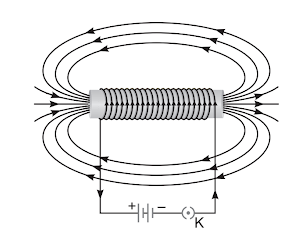
Ans: A solenoid acts as a magnet when current passes through it as it has two runs and from the positive side the electric field lines are generated and on the other side they emerge. so they form an electric field around the solenoid.
7. (a) What is ozone? How is it formed in the upper layers of the Earth's atmosphere? How does ozone affect our ecosystem? (2 Marks)
Ans: Ozone is a molecule containing three atoms of oxygen ${{O}_{3}}$ a highly poisonous gas present in the upper layer of the atmosphere.
Formation of Ozone: The UV radiations split molecular oxygen ${{O}_{2}}$ apart into free oxygen atoms O + O. These atoms then combine with molecular oxygen to form ozone. ${{O}_{2}}$ → O + O O + O2 → ${{O}_{3}}$
Effect: Ozone layer shields the surface of the earth from damaging UV radiations of the sun.
OR
(b) (i) List two human-made ecosystems. (1 Marks)
Ans: The two human-made ecosystems are:
i) Gardens
ii) park
(ii) "we do not clean the pond in the same manner as we do in an statement
aquarium. " give reason to justify this statement.
Ans: Ponds and lakes are natural habitats. They contain various decomposers that act as cleansing agents. In contrast, the aquarium is an artificial habitat. No such decomposers are present in it. Hence, it needs to be cleaned.
SECTION B
8. (a) List two advantages of adopting the atomic number of an element as the basis of classification of elements in the Modern Periodic Table.
Ans: In Modern periodic table noble gases in a separate group named as group-18. In this table transition elements are placed in separate blocks.
(b) Write the electronic configurations of the elements X (atomic number 13) and Y (atomic number 20). (3 Marks)
Ans: The electronic configurations of the elements X (atomic number 13) and Y (atomic number 20) are:
X - 2, 8,3
Y - 2,8,8,2
9. (a) Draw two different possible structures of a saturated hydrocarbon having four carbon atoms in its molecule. What are these two structures of the hydrocarbon having the same molecular formula called? Write the molecular formula and the common name of this compound. Also write the molecular formula of its alkyne. (3 Marks)
Ans:
i)
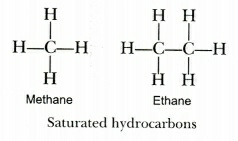
ii) They are called isomers
iii) molecular formula
a) $C{{H}_{4}}$
b) ${{C}_{2}}{{H}_{6}}$
Common name & alkyne formula
a) methane, $C{{H}_{2}}$
b) ethane, ${{C}_{2}}{{H}_{4}}$
OR
(b) (i) Write the molecular formula of benzene and draw its structure.
Ans: Molecular formula of benzene is ${{C}_{6}}{{H}_{6}}$.
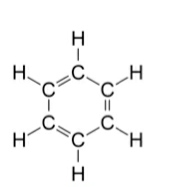
(ii) Write the number of single and double covalent bonds present in a molecule of benzene.
Ans: ${{C}_{6}}{{H}_{6}}$ has c-c single and double bonds with 9 single bonds and 3 double bonds.
(iii) Which compounds are called alkynes? (3 Marks)
Ans: Compound have one or more carbon-carbon triple bonds.
10. (a) Mention one function each of the following organs in human male
reproductive system:
(i) Testis
(ii) Scrotum
(iii) Vas deferens
(iv) Prostate gland
Ans:
i) To produce sperm and to control secondary sexual character in male.Testis not only produces sperm but also produces the male androgen hormone which is essential for the development of male.
ii) lt acts as a bag to hold the testis and it maintains a cooler temperature for sperm production.(2-2.5°) lower than the body temperature.
iii) It is a conducting tube which moves sperm out of the testis. After the vas deferens, it goes into the ejaculatory duct.
iv) prostate gland provides nourishment and mobility to sperms.
(b) Name the type of germ cell which (i) is motile, and (ii) stores food. (3 Marks)
Ans:
i) The male gamete is the motile germ cell that is Sperm
ii) The female gamete is the germ cell that contains the stored food that is Ovum.
11. (a) Three resistors R1, R2 and R3 are connected in parallel and the combination is connected to a battery, an ammeter, a voltmeter and a key. Draw a suitable circuit diagram to show the arrangement of these circuit components along with the direction of current flowing.
Ans:
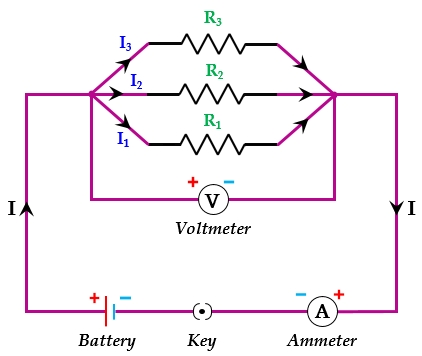
(b) Calculate the equivalent resistance of the following network:

Ans:
12. (a) (i) Define Electric Power and write its SI unit. (2 Marks)
Ans: Electric power is the rate at which electrical energy is transferred by an electric circuit. The SI unit of power is the watt, one joule per second.
(ii) Two bulbs rated 100 W; 220 V and 60 W; 220 V are connected in parallel to an electric main of 220 V. Find the current drawn by the bulbs from the mains. (2 Marks)
OR
(b) (i) state joule's law of heating. Express it mathematically when an appliance of resistance R is connected to a source of voltage V and the current I flow through the appliance for a time t.
Ans: Joule’s law of heating states that the power of heating generated by an electrical conductor is proportional to the product of its resistance and the square of the electric current passing through the conductor. It Express mathematically as: ${{I}^{2}}RT$
(ii) A 5-ohm resistor is connected across a battery of 6 volts. Calculate the energy that dissipates as heat in 10 s. (3 Marks)
Ans: Using Ohm's law
$I=\frac{V}{R}$
$I=\frac{6}{5}$
$=1.2$Ampere
Heat produced-${{I}^{2}}RT$
$\Rightarrow 1.2\times 1.2\times 5\times 10$
$=72$ joules
13. (a) Name the group of organisms which form in the first trophic level of all food chains. Why are they called so?
Ans: The group of organisms which form in the first trophic level are producers.
They called producers because they make their own food.
(b) Why are human beings most adversely affected by biomagnification?
Ans: Human beings occupy the top place of most trophic level and we know that concentration of harmful chemicals increase as we go above the trophic level. Therefore, human beings are most adversely affected by biological magnification.
(c) State one ill-effect of the absence of decomposers from a natural ecosystem. (3 Marks)
Ans: In the absence of decomposers recycling of material in the biosphere will not take place which would lead to the accumulation of dead plants and animals in the environment.
SECTION C
This section has 2 case-based questions (14 and 15). Each case is followed by 3 sub-questions (a), (b) and (c). Parts (a) and (b) are compulsory. However, an internal choice has been provided in Part (c).
14. The mechanism by which the sex of an individual is determined is called sex-determination. In human beings, sex of a newborn is genetically determined, whereas in some others it is not. There are 46 (23 pairs) chromosomes in human beings. Out of these, 44 (22 pairs) control the body characters and 2 (one pair) are known as sex chromosomes. The sex chromosomes are of two types X chromosome and Y chromosome. At the time of fertilisation, depending upon which type of male gamete fuses with the female gamete, the sex of the newborn child is decided.
(a) Why is a pair of sex chromosomes in human beings called a mismatched pair in terms of type and size? (2 Marks)
Ans: A pair sex chromosome can have two same types of chromosomes (homogamety) or two different types of chromosomes (heterogamety). Humans show male heterogamety, meaning they have two mismatched chromosomes as a pair. The other 22 pairs of chromosomes are the same for all, male and female.
(b) Out of male or female, which of them has a perfect pair of sex chromosomes? In case of a perfect pair, will the gametes produced be of the same kind or of a different kind?
Ans: Girls only. Humans have 23 pairs of chromosomes out of which 22 pairs of chromosomes are called autosomal chromosomes. In the cell nucleus of human beings, there are 46 chromosomes in total (i.e.) 23 pairs of chromosomes.
(c) (i) Name two animals whose sex is not genetically determined. Explain the process of their sex determination.
Ans: Examples of organisms in which sex is not genetically determined are crocodiles, alligators, turtles, tuatara et cetera.
In these organisms, sex is determined by environmental factors. For example, in crocodiles, if the egg is incubated at around 30 °C, it leads to the development of the female whereas if the egg is incubated at around 34 °C, it results in the development of the male.
OR
(ii) With the help of a flowchart only, show how sex is genetically determined in human beings.
Ans:
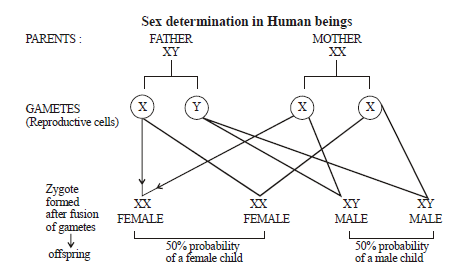
Ans: Humans have 46 chromosomes present in pairs. In male there are 22 autosomes and one pair is sex chromosome XY .In females there are 22 autosomes and one pair is sex chromosome XX. So sex of a human baby is determined by male , not by the female.
15. A student fixes a sheet of white paper on a drawing board using some adhesive materials. She places a bar magnet in the centre of it and sprinkles some iron filings uniformly around the bar magnet using a salt-sprinkler. On tapping the board gently, she observes that the iron filings have arranged themselves in a particular pattern.
(a) Draw a diagram to show this pattern of iron filings. (1 Marks)
Ans:
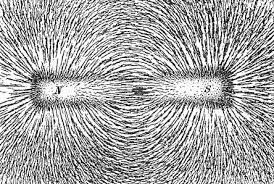
(b) Draw the magnetic field lines of a bar magnet showing the poles of the bar magnet as well as the direction of the magnetic field lines. (1 Marks)
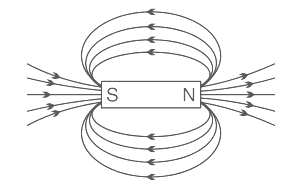
Ans: The magnetic field arise from the north pole and emerges into the South Pole of the magnet.
(c) (i) How is the direction of the magnetic field at a point determined using the field lines? Why do two magnetic field lines not cross each other? (2 Marks)
Ans: The direction of a magnetic field at a point is determined by placing a small compass needle. The N - pole of the compass indicates the direction of the magnetic field at that point.
Two magnetic field lines do not cross each other because there will be two directions of the field at the same point.
OR
(ii) How are the magnetic field lines of a bar magnet drawn using a small compass needle? Draw one magnetic field line each on both sides of the magnet.
Ans: If you place a compass near the north pole of a magnet, the north pole of the compass needle will be repelled and point away from the magnet. Thus, the magnetic field lines point away from the north pole of a magnet and toward its south pole.
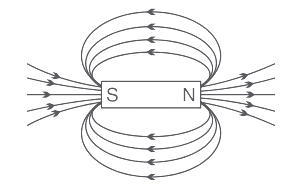
Importance of CBSE Previous Year Question Papers Class 10 Science
Class 10 Science is an important subject for engineering and medical aspirants. This subject also holds the key to a good score in the CBSE Board exam. Hence it is a crucial subject to prepare and score well.
CBSE Class 10 Science Syllabus covers the fundamental chapters based on Physics, Chemistry, and Biology. The chapters are chosen following a pattern to develop a conceptual foundation among the students. They will find it easier to understand the chapters after what they studied in the previous classes.
These chapters are included to ensure a strong base of fundamental principles is developed within the students so that they can find studying advanced chapters in the higher classes easier to comprehend.
Hence, solving the previous year’s CBSE Class 10 Science Term 2 paper is important. The questions from the important chapters are covered in this paper. Students will use this exam paper as a reference to practise answering science questions.
By referring to the solutions, they can figure out which chapter to focus more and make their preparation better.
Benefits of CBSE Class 10 Science Question Paper 2022 with Answers
The exclusive benefits of solving the CBSE Class 10 Science Term 2 2022 question paper with solution are:
Get to know your preparation level using this 2022 Term 2 paper as an evaluation tool. Check your answers and find out which chapters need more attention.
Find out how the experts have formulated the answers by following the CBSE guidelines. Follow the answering format given in the solutions to sharpen your answering skills.
Practising science questions will also make you more efficient in saving time and scoring more in the board exam.
Get to know the questions asked from the fundamental chapters of CBSE Class 10 Science. Prepare those chapters by learning the marking scheme by solving these papers.
Develop your strategy to answer the CBSE Science exam paper and learn how to use your time to score better.
Download Class 10 Science Board Question Paper 2022 with Solutions Free PDF
Perform the CBSE Class 10 Science Question Paper 2022 PDF download and complete your study material for CBSE Class 10 Science. Prepare the chapters well and practise solving this question paper. Enjoy the benefits mentioned above and make your preparation stronger for this subject.
FAQs on CBSE Class 10 Science Term 2 Question Paper 2022 with Solution
1. What is the reason for following CBSE Class 10 Science syllabus?
By following the CBSE Class 10 Science syllabus, you can easily understand the score weightage of the chapters included. In this way, you can divide your preparation time more efficiently.
2. Does solving CBSE Class 10 Science Board Exam papers make you better?
You can use the previous year’s board exam paper for Class 10 Science as an evaluation tool. You can use it to find out your preparation level and can focus on specific chapters more.
3. Why should you follow the solutions framed by Vedantu experts in the Class 10 Science 2022 Question Paper?
Following the answering format of the experts will make you better at answering fundamental science questions in the board exam. You will be able to score more.
4. Is the CBSE Class 10 Science 2022 Term 1 exam paper and solution available for free?
Yes. You can download the previous year’s question paper and solutions for free at Vedantu.








































